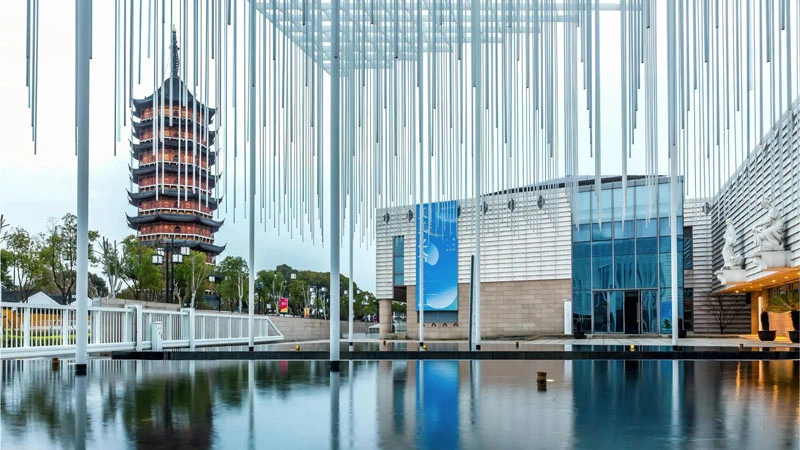A Poetic Past in Suzhou's Moonlit Nights
More than 1,200 years ago, a young poet found himself in Suzhou on an autumn night, standing by the famous Fengqiao bridge. Mesmerized by the serene beauty of the Jiangnan water town, he penned a timeless verse that would resonate with generations:
"The moon sinks, crows cry, frost fills the sky, River maples and fishing lights fill the traveler's sorrow. Outside Gusu City, by Hanshan Temple, The midnight bell reaches my boat."
This famous poem by Zhang Ji painted a vivid picture of the cold night in Gusu City (now Suzhou), with its striking moonlit landscapes. Since then, the poem and Suzhou's sights, especially Hanshan Temple and its evening bell, have drawn countless visitors seeking the poetic charm of the city. But this year, Suzhou is offering something different for its Mid-Autumn Festival—a cultural extravaganza that blends history with celebration, transforming the melancholy of the ancient poem into modern-day festivity.

Shishan: Suzhou's New Cultural Landmark
Shishan (狮山), or Lion Mountain, sits in the western part of Suzhou and is known for its majestic granite slopes. Historically, Shishan was known as the backdrop to Suzhou's tranquil countryside. Today, it's a key cultural site and a new urban landmark. The name "Lion Mountain" stems from its shape, which resembles a lion gazing at nearby Tiger Hill, a scenic pairing that has long been celebrated in Suzhou lore.
In contrast to the historical significance of Tiger Hill, Shishan represents Suzhou's modern side. Once home to the old Suzhou Amusement Park, Shishan has transformed into a vibrant cultural center, attracting visitors from near and far. The Lion Mountain Cultural Plaza, where the Mid-Autumn market will take place, is now a hotspot for urban culture, blending the city's ancient charm with its future-forward spirit.
The Plaza is also the site of the Suzhou Museum West, designed by the world-renowned German architecture firm GMP. Since its opening in 2021, the museum has become a symbol of Suzhou's contemporary cultural innovation. Its sleek, futuristic design contrasts beautifully with Suzhou's classical gardens, offering a perfect blend of old and new. The museum's exhibitions, often featuring collaborations with international institutions, have made it a must-visit spot for both locals and tourists.
Suzhou: Where Culture Blooms Among the Museums
Suzhou, one of China's first National Historical and Cultural Cities, boasts over 2,500 years of history. Known for its economic prosperity and cultural richness since the Spring and Autumn period, Suzhou today stands as a city that is just as vibrant as ever. In fact, Suzhou is now referred to as the "City of Museums." With 127 museums scattered throughout the city, it offers an unparalleled glimpse into history, art, and culture.
Walking through Suzhou's streets is like strolling through an open-air museum. The city's museums, from the renowned Suzhou Museum designed by the legendary architect I.M. Pei to smaller niche museums, are part of everyday life. For example, the Suzhou Silk Museum captures the region's rich history of silk production, while the Kunqu Opera Museum pays tribute to the artistic heritage of the local opera.
One notable cultural hub is the Suzhou Museum West, located at Shishan Cultural Plaza. Opened in 2021, it showcases international collaborations and modern exhibitions, adding a dynamic flair to the city's cultural scene. Alongside it are the Suzhou Science Museum and Shishan Grand Theater, forming a new cultural landmark that perfectly blends traditional Chinese elements with modern architecture.
A Night Market of Culture: Mid-Autumn at Shishan
In Suzhou, life truly begins after sunset. As the pace of modern life grows more hectic, the city's night culture has become a refuge for those looking to escape the daily grind. Whether you're wandering through the serene Suzhou gardens, enjoying a moonlit boat ride on Tiger Hill, or strolling through the vibrant Shishan Cultural Plaza, Suzhou offers a unique blend of old-world charm and contemporary delights.
The "Most Chinese: Cultural and Museum Night Market" encapsulates this perfectly, bringing people together to celebrate not only the Mid-Autumn Festival but also the enduring cultural spirit of Suzhou. Under the bright full moon, amidst the glow of lanterns and the hum of festivities, Suzhou invites everyone to pause, connect, and rediscover the beauty of life through its rich cultural heritage.
Suzhou isn't just a place to visit—it's an experience to savor. So, when you look up at the moon on September 15-17, remember: Suzhou's Lion Mountain will be shining just a little brighter, waiting to welcome you to a night full of wonder.
This year's Mid-Autumn Festival brings an exciting new event to Suzhou—"Most Chinese: Cultural and Museum Night Market". Set against the backdrop of Shishan, also known as Lion Mountain, this cultural night market is a collaboration of over 30 museums and cultural institutions, hosted from September 15-17, 2024.
The event is part of China National Geography's cultural brand activities, which aim to bring museum and cultural products to new audiences. Following successful events in Beijing and Quanzhou, this Suzhou night market marks the first of its kind in Jiangnan (South of the Yangtze River), making it an unmissable cultural spectacle.
At the heart of the market, visitors will find cultural creations, artifacts, and creative products that reflect the rich heritage of Suzhou and beyond. From intricate silk items to stunning porcelain wares, the market will feature a fusion of traditional and contemporary designs. It's a chance for culture enthusiasts, tourists, and locals to connect, share stories, and experience Suzhou's history in an entirely new light.
In a city that already feels like a living museum, this night market offers a more intimate, immersive experience, where the past meets the present under the glow of the Mid-Autumn moon. Visitors will not only enjoy the rich cultural products on display but also engage in workshops, performances, and culinary delights, making this a multi-sensory celebration.



